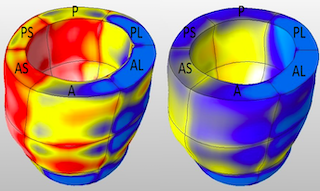Kardia: Driving a new paradigm in cardiac imaging visualization
by John Hawkins
Kardia early stage company focused on applying AI / ML to the cardiac MRI.
Lowell, MA United States Equity Raise Cross Clubhouse Community Crowd challengeAbout our project

The problem we solve: Heart disease is the leading cause of death and the most costliest of diseases. Kardia answers the most important question in heart failure - what is the impact to the heart's ability to pump blood? Answering this question enables clinicians to plan treatment. Our solution will help improve care at the patient level, and address the high cost of heart disease.

About our solution: Kardia is a SaaS model that processes a cardiac MRI through API's. Our model augments the current radiology workflow, and provides a 3D color video demonstrating heart muscle viability.
Progress to date:
Product Traction to date:
-
Over the past 15 years we have run 9 clinical validation studies funded by the NIH (10M USD in funding).
-
Led to publishing numerous papers, and Two Patents on our methodology
-
Systolic Strain Analysis - strain orientation in the normal human left ventricle
-
Using cMRI to map Myocardial viability ( tissue alive or dead)
-
-
Proprietary DB of the Normal Human Heart on cMRI
-
Negotiated favorable license terms with the Office of Technology Management at Washington U.
-
in q4 2020 Product pre market fit in the cardiology and radiology ecosystem
-
ACC, ACR
-
Industry including MRI OEM, radiology RIS/PACS and Reporting ecosystem
-
Cardiologists and Radiologist
-
-
Signing first partnership with Pheonmx, and several Heart Failure clinics as Beta Sites
About Our Team

Creator: John Hawkins
Location: Massachusetts
Bio: Innovative leader driving change in the cardiac imaging space. John brings 30 years experience in Health Information Technologies, including co-founding Kardia, a start up company applying AI/ML to the cardiac MRI.
Title: CEO and Co-Founder
About Team Members
Michael Pasque
Founder and Chief Medical Officer, Thoracic Surgery–Certified Transplantation Surgery–Qualified
Biography: Dr. Pasque, (Mike) to his family and friends, is Board Certified in Thoracic and Transplantation Surgery. Mike practices in St. Louis Mo. at Barnes-Jewish Hospital, St. Louis Children's Hospital, and the VA Medical Center. In addition, Mike is a Professor, Surgery Division of Cardiothoracic Surgery at Washington University.
Mike set out thirty years ago building an answer to this question - is there a better way to understand cardiac ischemia, and contractile injury to the left ventricle than the status quo?
Mike and the team have an answer - Kardia, by applying machine learning and algorithms to a Cardiac MRI, we can now see at the micro-regional level the contractile injury to the heart.
In his spare time Mike enjoys - spending time with family and friends, down time on his ranch, and learning python and apply to apply the power of the computer to improve patient care.
Title: Founder and Chief Medical Officer
Advanced Degree(s): Thoracic Surgery–Certified Transplantation Surgery–Qualified
LinkedIn:
https://surgery.wustl.edu/people/michael-pasque/
Brian Phelan
Co-Founder, Investor Relations, West Point Graduate
Biography: Brian is an experienced executive with a proven track record of working with small companies to turn them into profitable businesses while growing them and preparing for an exit.
Brian is experienced in M&A , international business development, international operations, operational start up and expansion.
Brain is a graduate of the United States Military Academy, West Point, and continues to serve our great country as a member of the United States Military Academy, Field Force Officer, evaluating and recommending for selection the next generation of student candidates who will go on to study and lead our military.
In his downtime Brian enjoys being a husband and father, the outdoors, golf, skiing, and is also passionate about grillin and chillin with family and friends.
Title: Co-Founder, Investor Relations
Advanced Degree(s): West Point Graduate
LinkedIn:
https://www.linkedin.com/in/brian-phelan-607971/
Dr. Khan Siddiqui
Advisory Board Member, MD
Biography: Khan is best known as a Serial entrepreneur, physician, innovator, former MSFT executive and unleashing and scaling AI - who strongly believes in the power of “paying it forward”.
Khan brings over 22 years of experience as a practicing clinician and technology professional. A visiting Associate Professor at the Department of Radiology at John Hopkins University School of Medicine, former Co-Director at the Center for Biomedical & Imaging Informatics, Johns Hopkins University. Prior to founding higi in 2012, Dr. Siddiqui was a Physician Executive and Principal Program Manager at Microsoft. Dr. Siddiqui has published dozens of peer-reviewed publications and holds 12 patents for technology in areas of deep learning, AI, image processing, data visualization, as well as securing patient information handling and health records.
Title: Advisory Board Member
Advanced Degree(s): MD
Twitter:
https://twitter.com/drkhan
LinkedIn:
https://www.linkedin.com/in/khansiddiqui/
About Our Company
Kardia
Location: 240 JACKSON STREET
SUITE 301
Lowell, MA 01852
US
Founded: 2021
Website: http://www.kardia.ai
Product Stage: Prototype/MVP
Employees: 5-10
How We Help Patients
Personally, I am a patient living with Chronic Heart Failure. (HFpEF).
I was diagnosed in April 2016 with a bad aortic valve and a large thoracic aortic aneurysm, requiring surgical repair and a lifelong prescription to heart meds.
Kardia helps patients like me:
- Screening - Kardia can be used for heart screening, detecting values, vasucular, and other cardiac abnormalities.
- Assessment - Kardia can provide a baseline assessment of a patients cardiac health.
- Medical and Surgical planning, Kardia provides clinicians with a detailed map of the heart, highlighting at a micro-regional level where the heart muscle is impacted by heart disease.
How We Help Physicians
Clinicains will benefit from Kardia -
- Micro regional assessment of the patients heart muscle based on a gold standard for cardiac function
- Kardia answers the most important question in heart failure management - is the cardiac tissue alive or dead?
- Answering this question enables the clinical to plan the appropriate clinical intervention.
How We Help Hospitals
Kardia will benefit the providers and heart failure clinics through
- Meeting appropriate use criteria
- Improved Macra and star ratings
- Increased cMRI volume to the imaging centers as more Cardiologists build Kardia into the patient work-up for heart failure
How We Help Partners
Kardia provides a unique feature for partners, the ability to rapidly assess heart failure and the impact of the disease to the contractile injury to the heart muscle. MRI OEM will benefit from licensing Kardia and offering the solution as a feature benefit to their customers.
Innovation Details
Intellectual Property Summary
1) US patent # US9176211B2 -“Method for quantitatively mapping myocardial contractile function with magnetic resonance based multiparametric strain analysis.”
2) US patent # US20180116521A1 -“Systems and methods for measuring cardiac strain.”
3) Proprietary Normal Human Strain Database (strain data at 15,300 LV grid-points; 140 normal volunteers)
Clinical Information
Machine Learning Outcome Prediction in Dilated Cardiomyopathy Using
Regional Left Ventricular Multiparametric Strain.
https://pubmed.ncbi.nlm.nih.gov/33006006/
MRI-Based Machine Detection of Regional Left Ventricular Contractile Injury
26. Pirolo JS, Bresian SJ, Vannier MW, Gayou DG, Cox JL, Pasque MK. Three dimensional solid modeling of the canine biventricular unit. Proceedings of the IEEE Engineering in Medicine and Biology Society, 12(1):389-391, 1990.
28. Creswell LL, Pirolo JS, Vannier MW, Gayou DG, Szabo BA, Myers KW, Cox JL, Pasque MK. Computer-aided 3D solid modeling of the canine biventricular unit. Surgical Forum, 41 274-276, 1990.
29. Pirolo JS, Creswell LL, Perman WH, Vannier MW, Pasque MK. Mathematical solid modeling of in-vivo human biventricular geometry. Surgical Forum, 42:218-220, 1991.
31. Pirolo JS, Creswell LL, Bresina SJ, Perman WH, Szabo BA, Myers KW, Vannier MW, Pasque MK. Regional myocardial stress distribution from magnetic resonance image-based mathematical models. Annals of Thoracic Surgery, 52:276-284, 1991.
36. Pirolo JS, Bresina SJ, Vannier MW, Creswell LL, Szabo BA, Myers KW, Pasque MK. Mathematical three-dimensional solid modeling of biventricular geometry. Annals of Biomedical Engineering, 21:199-219, 1992.
37. Creswell LL, Pirolo JS, Szabo BA, Myers KW, Bresina SJ, Perman WH, Vannier MW, Pasque MK. Estimation of regional myocardial stress; p-version finite element analysis using an MRI-based solid mathematical model. Automedica, 14:319-334, 1992.
39. Pirolo JS, Branham BH, Creswell LL, Perman WH, Vannier MW, Pasque MK. Pressure-gated acquisition of cardiac magnetic resonance images. Radiology, 183:487-492, 1992.
40. Creswell LL, Wyers SG, Perman WH, Vannier MW, Szabo BA, Pasque MK. Regional myocardial wall strain using magnetic resonance imaging: a new method for validation of mathematical models of the heart. Surgical Forum, 43:283-286, 1992.
Regulatory Status
Kardia will apply for 510K. There are several predicate devices that we will base our filing on.
How we will use the funds raised
- Technology optimization
- 510K application
- Business operations leading to commercialization
Thank You
We are seeking investors to share our vision and fuel our growth from the lab at Washington University to a commercial product. We are currently raising to fund our operations to penetrate the market and improve healthcare outcomes for patients and the payor.
Investor Info
Market Size
Well published that heart disease is the leading cause of death and the most costliest of the diseases.
We are looking at the market though this perspective:
- 7,350,000 patients with Heart Failure (HFpEF or HFrEF)
- 26,000 cardiodiologist in the USA, and only 500 Heart Failure Specialist - There is a large buden on the cardiology providers
- CMS paid for 900,000 cMRI by CPT code in 2019, the number will drop in 2020 (Covid) but more cardiologists are ordering the cMRI so we expect the cMRI to raise
- Pharma has over 5,000 heart failure clinical trials in the recruitment phase. Supporting clinical trials is a target for Kardia.
Projected 3 Year Growth
Kardia anticpates converting Beta sites into paid customers, with a steady customer aquisition model over the next 3 years.
| Funding + 12 Months (2021) |
Funding + 24 Months (2022) |
Funding + 36 Months (2023) |
36 Month Funded Model 21 -22- 23 Totals |
||||
| Revenue | Customers | Total | Customers | Total | Customers | Total | |
| Hospital Provider / License Deals | 5 | $313,764 | 25 | $1,568,818 | 75 | $4,706,454 | $6,589,036 |
| Pharma | 1 | $250,000 | 8 | $2,000,000 | 20 | $5,000,000 | $7,250,000 |
| Total | 0 | $563,764 | 33 | $3,568,818 | 95 | $9,706,454 | $13,839,036 |
Kardia plans on managing the business with an eye on profitability by year 2.
| 2021 | 2022 | 2023 | Total | ||||
| Operating Expense | $894,000 | $2,551,000 | $2,955,250 | $6,338,250 | |||
| Cost of Goods Sold | $285,000 | $660,000 | $782,500 | $1,727,500 | |||
| Gross Margin | 49.45% | 81.51% | 91.94% | 87.52% | |||
| Profit Margin | -177.42% | 8.63% | 60.87% | 38.14% | |||
| Net Profit | -$1,000,236 | $307,818 | $5,908,704 | $5,278,286 |
Revenue Model
The Kardia revenue model and customer aquisition approach:
- License to the MRI and radiology ecosystem as a software feature (GE value add to their customers)
- Promote and sell directly to the top 20 hospitals with large heart failure clinics, Mayo, Cleveland Clinic, MGB, Standord
- Promote and license to the Pharma industry focused on measuing heart failure during cardiac or chemo clinical trials
Competitors
There are several competitors fighting for post processing of the cMRI, and cardiac imaging.
Notable competitors include:
cardiowise and heartflow.
Both companies analyze the CT - which can introduce harmful radiation to the patients.
| Company/ Product | cMRI Product | Strengths |
| Kardia | Kardia | Human based propriatery DB of the normal heart on cMRI. Vizualize cardiac muscle (Epi, Myo, Endo) at the microregional level on cardiac MRI. 2 Patents on using cMRI to detect cardiac viability. |
| Myocardial Solutions | MyoStrain | Management Team Johns Hopkins University FDA 510K Clearance |
| Galgo Medical |
ADAS 3D | The software consists of two post-processing modules for the Left Ventricle (LV) and Left Atrium (LA). Both modules automatically identify areas of LV/LA fibrosis and enable viewing adjacent structures to the chamber of interest, providing quick and easy to use quantification and visualization tool. Can process both MRI and CTA CT angiography. |
| MEDIS MEDICAL IMAGING SYSTEMS, B.V | QMass - for CT and CMRI | LV and RV function analysis Global function analysis (Simpson’s method) on short axis or transversal stack of cines Quantification of custom volumes, such as atrial volumes Area-length and Bi-plane volumetric analysis methods for long axis cines Automatic contour detection of LV endo and epicardium and RV endocardium, semi- automatic contour editing “LiveContour” algorithm to quickly detect endocardial contours Automatic exclusion of images in short axis based on information in long axis ? Auto-detection of papillary muscles and trabeculae with “MassK mode” Quantification of EDV, ESV, SV, %EF, CO, CI, indexed values (BSA and height), (time to) peak filling and ejection rate ? Various BSA calculation methods for indexed results Various normal ranges possible, calculation of z-scores Analysis of regional parameters, such as wall motion, wall thickness, wall thickening and wall thickness changes over time |
| CARDIOVASCULAR IMAGING SOLUTIONS LTD.1600 MANCHESTER WAYCorinth, TX 76210 | CMRTOOLS AND PLUG-INS VENTRICULAR TOOLS & THALASSAEMIA TOOLS | CMRtoolSTM is a software package for the visualization and analysis of cardiovascular magnetic resonance images (CMR). CMRtooISTM is comprised of an image loader, an image viewer and a set of optional plug-ins for specialist cardiac analysis, including VentricularTools and ThalassaemiaTools. * VentricularTools provides dedicated functionality for calculating volume and mass indices of the ventricles of the heart from magnetic resonance images. * ThalassaemiaTools allows the calculation of a property called T2* that characterizes iron loading in the heart and liver |
| GE | Cardiac VX | CardiacVX is a post-processing analytical software application, which provides tools: for the review and reporting of cardiac MR datasets. Measurement tools on the report interface include: point, distance, area, and volume melasurements (including ejection fraction, cardiac output, end-diastolic volume, end-systolic volunme, and volume flow measurements). Semi-automatic tools are availablefor left ventricular contour detection, valve plane detectioni, vessel contour detection for flow analysis, signal intensity analysis for myocardium and infarct sizing measurement, T2 Star analysis, and patent foramen ovale (PFO) anal ysis. The GE CardiacVX forIMR] is an analytical software tool, which provides reproducible tools for the review and reporting of medical images. CardiacVX can import medical images from a MR system and displaythemn in a viewing area on the computer screen. The viewing area allows the access to multiple studies and series of multi-slice, multiphase images. Multi-phase sequences of images can be displayed in a cine mode to facilitate visualization. A report input interface is also available. Measurement tools on the report interface make :it possible to quickly and * reliably fill out a complete clinical report of an imaging exam. Available tools include: point, distance, area, and * volume mecasurement tools such as ejection, fraction, cardiac output, end-diastolic volume, end-systolic volume, and * volume flow measurements. Semi-automatic tools are available for left ventricular contour detection, Valve plane detection, vessel contour detection for flow analysis, signal intensity analysis for myocardium and infarct sizin~g measurement, and T2 Star analysis. |
| PIE MEDICAL IMAGING B.V. | CAAS MRV Version 3.0 | The intended use of CAAS MRV is to enable the user to: 1. Delineate the inner and outer wall of the ventricles automatically or semi-automatically, as well as the papillary muscles, on MR images 2. Derive from these contours the global and regional functional parameters like Ejection Fraction, Stroke Volume, Wall Movement etc. The CAAS MRV has been designed to be used in eveiyday clinical practice to support clinical diagnoses, as well as for research purposes like clinical research trials. |
| Arterys | Arterys Cardio DL | Quantification: - Anatomy and tissue segmentation - Distance and area measurements - Cardiac function quantification including stroke volume, ejection fraction, cardiac output, end-diastolic mass and volume, end-systolic mass and volume - Flow quantification, including net flow, forward flow, reverse flow, regurgitation fraction, pressure gradient and primary flow direction, at user-specified locations where contours have been created (e.g. aortic valve, pulmonary valve, mitral valve, tricuspid valve, superior vena cava) - Phase correction |
| Arterys | Arterys Software v 2.0 | Same as above |
| MORPHEUS IMAGING, INC 1700 4TH STREE MC 2522 BYERS HALL 214 San Francisco, CA 95158 |
HEARTSCAN SOFTWARE | HeartScan consists of software that analyzes DICOM-compliant cardiovascular images acquired from magnetic resonance (MR) scanners. HeartScan specifically analyzes the blood flow to the heart and its major vessels using multi-slice, multi-phase and velocity encoded MR images. It provides clinically relevant and reproducible, quantitative data and has been tested and validated on MR images acquired from both I.5T and 3:0 T MR Scanners. The data produced by HeartScan is intended to be used to support qualified cardiologist, radiologist or other licensed professional healthcare practitioners for clinical decision making. It is a support tool that provides relevant clinical data as a resource to the clinician and is not intended to be a source of medical advice or to determine or recommend a course of action or treatment for a patient. |
| MEDVOXEL SYSTEMS INC 2867 CROSSCURRENT DRIVE Mississauga, CA L5n 6l1 |
HeartPro | HeartPro consists of software that analyzes DICOM-compliant cardiovascular images acquired from magnetic resonance (MR) scanners. HeartPra specifically analyzes the blood flow to the heart and its major vessels using multi-slice, multi-phase and velocity encoded MR images. It provides clinically relevant and reproducible, quantitative data and has been tested and validated on MR images acquired from both 1.5T and 3.0 T MR Scanners. The data produced by HeartPro is intended to be used to support qualified cardiologist, radiologist or other licensed professional healthcare practitioners for clinical decision making. It is a support tool that provides relevant clinical data as a resource to the clinician and is not intended to be a source of medical advice or to determine or recommend a course of action or treatment for a patient. |
| SIEMENS MEDICAL SOLUTIONS USA, INC. 51 VALLEY STREAM PKWY. Malvern, PA 19355 -1406 |
LEONARDO SYNGO CARDIOLOGY WORKSTATION | LEONARDO syngo Cardiology offers a comprehensive cardiology solution to view, optimize, post-process diagnostic information and aid the doctors in the evaluation of digital cardiological and radiological examinations and patient information. |
| Syngo.CT CaScoring | CT Calcium scoring majoring coronary artieries | |
| Cardiowise | https://www.cardiowiseinc.com/ | CardioWise's non-invasive Cardiac Computed Tomography (cCT) analysis software produces an easy-to-understand 3D image model of the human heart. |
| Heartflow | https://www.heartflow.com/ | Cardiac CT for blood flow |
Traction
Kardia has signed two letters of intent to license the product as a complementive service to:
- https://phenomx.co/
- https://www.heartbeathealth.com/
In addition, Kardia is working through signing several Beta sites, heart failure clinics.
Due Diligence Docs
Please note that access to the company's confidential materials is limited. Click this button to request access from the Company and its representatives.
Updates
No updates found .
Supporters
Help us find best new ideas to fund by telling us what you think. Your feedback goes straight to the team behind this project in private, so tell them what you really think.
Index Score
1
Score
0
Score
1
Likes0
Partners0
Pilots0
Follows-
This campaign has ended but you can still get involved.See options below.
Help us find best new ideas to fund by telling us what you think. Your feedback goes straight to the team behind this project in private, so tell them what you really think.




